Culture
Catedral de Santiago Foundation
The Catedral de Santiago Foundation was established on July 23, 2008. It is registered in the Reinstatement of Fundacións de Interese Galego, of the Xunta de Galicia.
Its aims are the promotion and diffusion of the Cathedral of Santiago de Compostela, its surroundings and its artistic and cultural heritage; as well as the management and exploitation of the infrastructures of the Cathedral of Compostela and its artistic and cultural heritage.
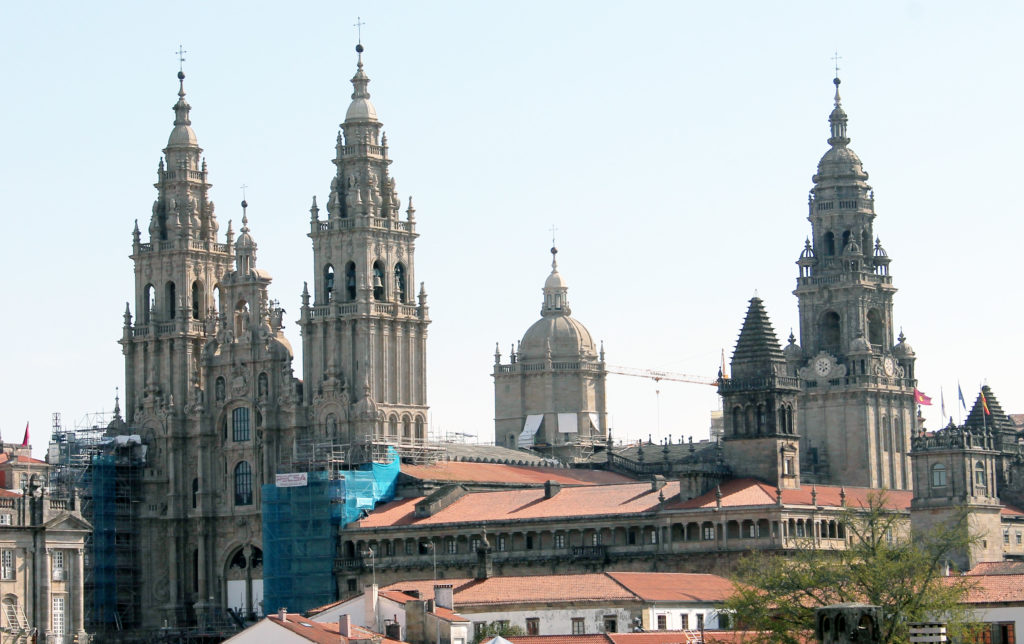
Museum
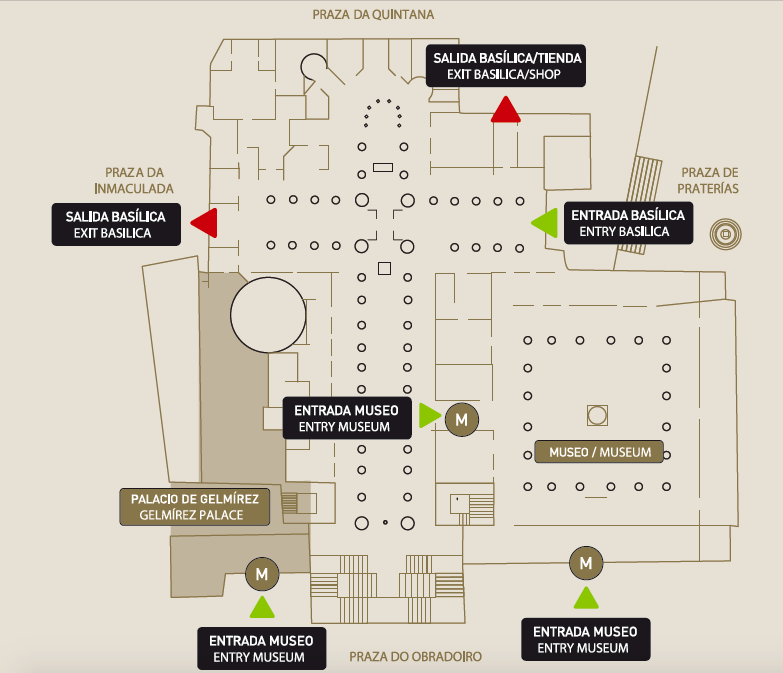
From Monday to Sundday, from 10 am to 8.
Tickets give access to various spaces and artistic collections of the Cathedral.
> Permanent collection – Cloister – Treasure and Chapel of Relics.
> Pazo de Xelmírez – Master Mateo Space.
> Pórtico de la Gloria.
> Roofs and Ratchet Tower.
In addition, the Compostela Sacra program, promoted by the Fundación Catedral de Santiago, makes it possible to visit the museum, cloister and church of Santa María de Sar.

A visit to the history and art of the Cathedral of Santiago through its best works of art. Visitors can journey back in time and discover how from a sepulchre a great cathedral is built. Around it, over the centuries, a city developed together with the Saint James phenomenon and The Way, which has played an important role in the building of the European identity and which has been a World Heritage Site since 1985.
- Ground floor: The origins of the Cathedral / Master Mateo’s Stone Choir / The building of the Romanesque cathedral
- 1st Floor: 13th and 14th century art in the Cathedral / 16th, 17th and 18th century art in the Cathedral / The Apostle Saint James
- 2nd Floor: Renaissance cloister / Chapel of the Relics / Royal Pantheon / The Cathedral’s Treasury / Chapter Library / Botafumeiro / Chapter Room
- 3rd Floor: Collection of textile art / Tapestries by Rubens / Tapestries by Teniers / Tapestries by José del Castillo / Tapestries by Goya / Obradoiro balcony

Romanesque style civil building annex to the Cathedral. It owes its name to Diego Gelmírez, first Archbishop of Compostela and promoter of the monuments ensemble. It is a splendid medieval architectural ensemble with Hall of Arms, Manrique Room, and Kitchen. Especially remarkable is its Ceremonial Room, with monumentally grandiose and beautiful decoration with illustrated corbels representing a royal banquet. It houses temporary exhibits and Master Mateo’s Space.
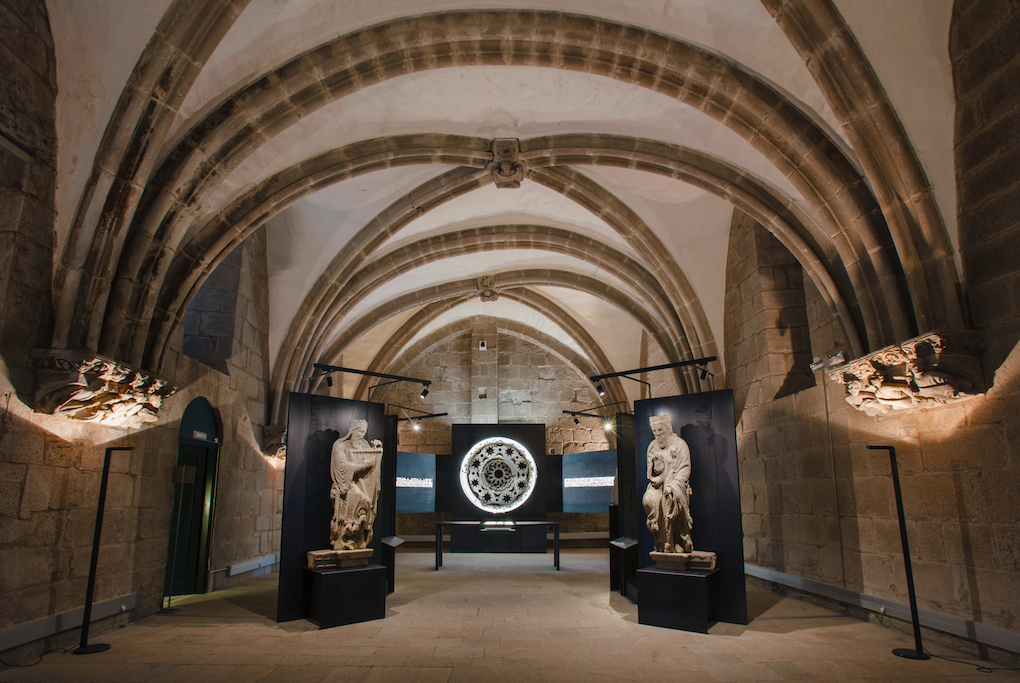
The Portico of Glory is the western entrance to the Romanesque cathedral. It was designed by the genius of Master Mateo, whose atelier of stonemasons interpreted the passages of the Apocalypse in stone. It is considered a masterpiece of universal art. Visitors may witness the restoration works, made with the patronage of Fundación Barrié.
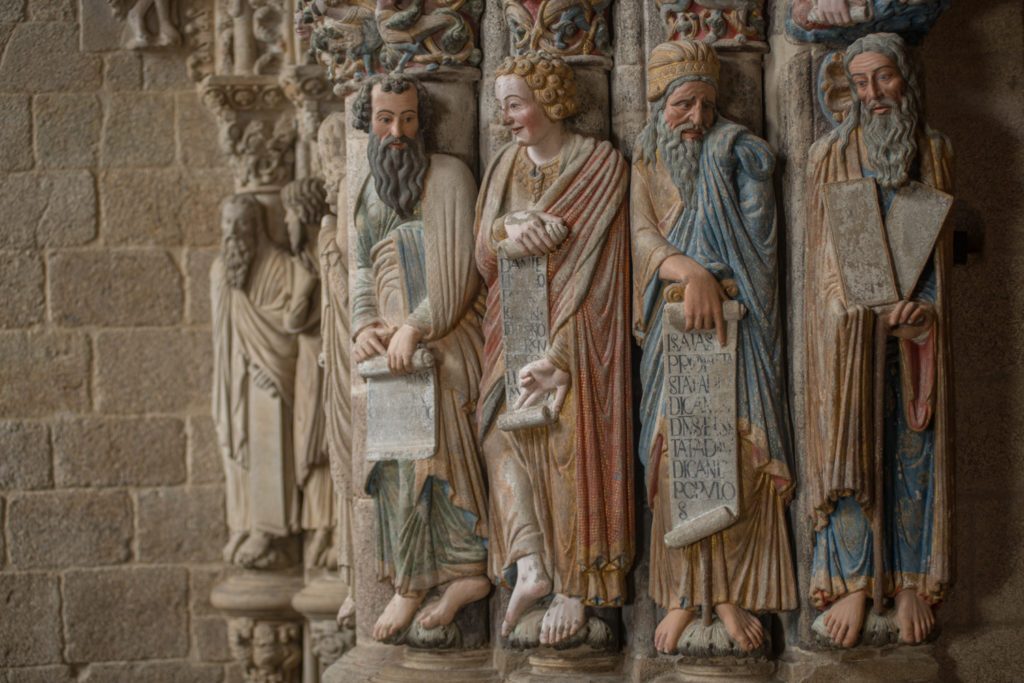
The stone rooftops of the Cathedral of Santiago are laid out in a staggered form and they can be visited. They offer spectacular views both of the basilica as of the city of Santiago de Compostela.
*Closed temporarily, for restoration works
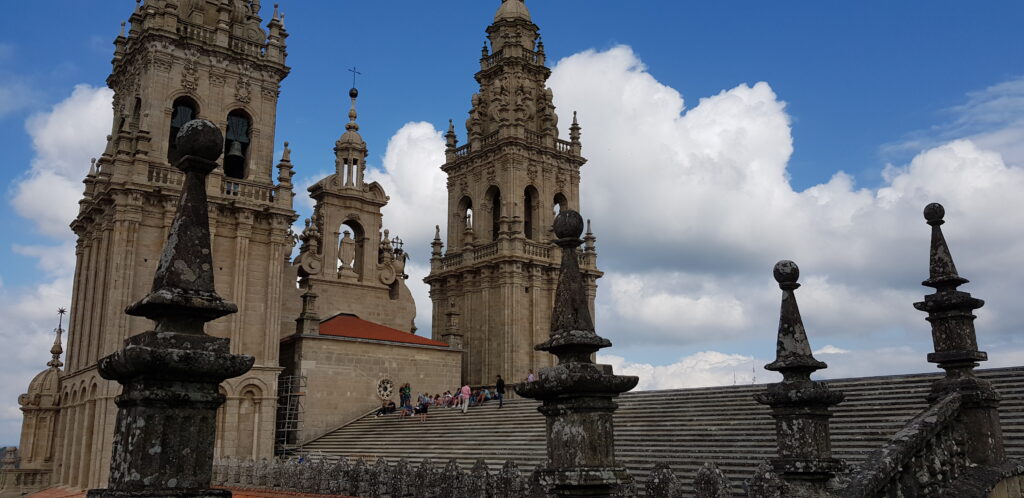
To save the slope between the head and the western end of the cathedral, Master Mateo came up with the construction of a crypt, unique in its form and function in the Galicia of the time.
It is a space of great architectural complexity, organized by a large pillar from which the arches that support the vaulting start. Also noteworthy are the capitals and the two angels of the keystones of the vaults of the transept, one carrying a sun and the other a moon, in clear allusion to the earthly world.

In the subsoil of the Cathedral, the archaeological excavations carried out during different periods have unearthed many vestiges of the origins of the basilica and of the city. Under the floor an intricate network of necropolis that began in Roman times and lasted until the construction of the Romanesque cathedral can be found, as well as the remains of the early basilicas and part of the first defensive wall around the city of Compostela.
*Closed temporarily.
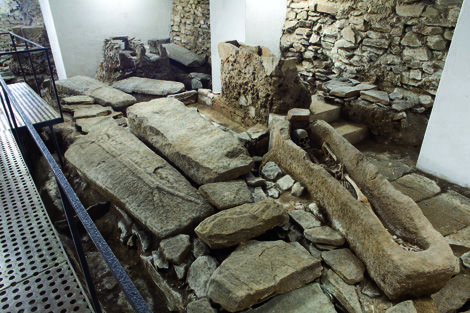

Digital Catalog
The Fundación Catedral de Santiago is promoting a project to digitize part of its cultural heritage and artistic collections. It is, firstly, to have digital resources for the documentation and conservation of the pieces and, secondly, to improve the public access to these works of art, some of them masterpieces to the history and art of Galicia.
This digital fund will be stored in a repository installed in the Museo Catedral, which will be a digital capsule of the cultural memory of the Cathedral of Santiago.
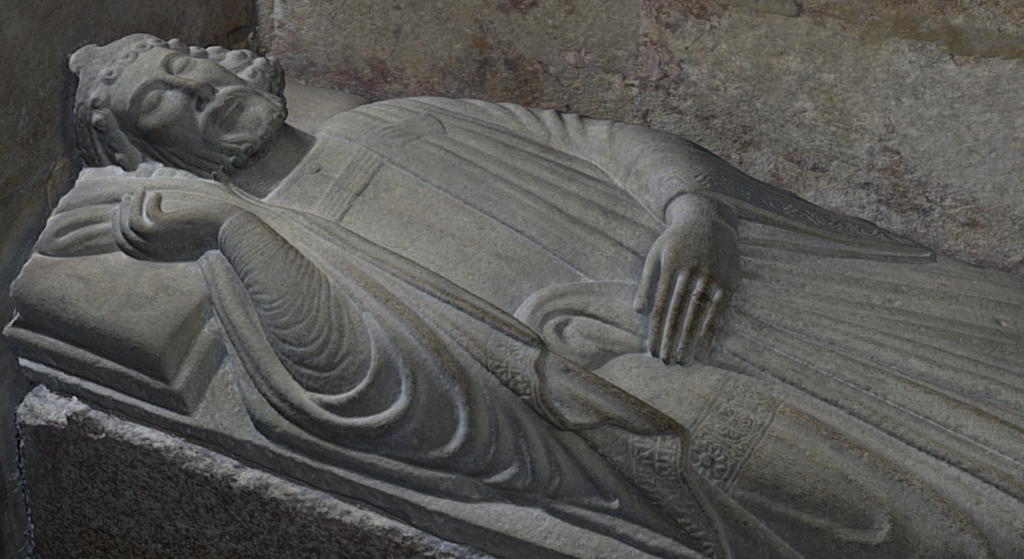
Archive-Library
Among the services offered by the Cathedral of Santiago Archive-Library (ABCS), the guided tours are an instrument for cultural activation, to attract society and educate users. Its purpose is to share the wealth of the documentary and bibliographic collections that it keeps (which include the Codex Calixtinus, Cartulary A and the Breviary of Miranda). But its purpose is also to disseminate the documentation and preservation technical works carried out in its interior, as well as to confirm the identity and memory of the Church and of the society it forms part of. All in all, the services it fulfils dissemination, cultural, educational, social and pastoral services.
Guided tours for groups between 6 and 15 people.
a) Special tours:
- Tuesday and Thursday at 11:00 am.
- Approximate duration: 1 hora.
- Price: 15 euros/person
b) Educational tours:
- Subject to availability.
- Approximate duration: 45 minutes.
- Price: 3 euros/ person
Information and bookings at: 981575609 or by email to archivo@catedraldesantiago.es (during opening hours).
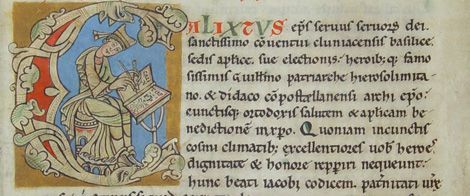
The Archive of the Cathedral of Santiago, no doubt one of the most important in Europe, houses books and documents of a high artistic value, whose origins go back as far as the first centuries of the Middle Ages. Together with the Library it is the trustee of the history of the Compostela See.
The same building houses the Archive, which guards and is responsible for the organisation, classification and service of the chapter documents. The Library, which amasses important collections from the 15th to 19th centuries, as well as other collections focused on documentation and support for research is also located here. Both work as a single activity, following common regulations and parameters that focus on facilitating the work of researchers.
Acceso: Sacristy (users must first be accredited at the Security Control Centre, located on the Treasury corridor).
Hours: from Monday to Friday, from 9:00 am to 1:30 pm. From Monday to Wednesday, from 4:30 pm to 7:00 pm.
Telephone: 981 575 609
Contact:
- Archive (general matters): archivo@catedraldesantiago.es
- Medieval documentation area: medieval@catedraldesantiago.es
- Modern and Contemporary Documentation Area: moderna@catedraldesantiago.es
- Library (general matters): biblioteca@catedraldesantiago.es
- Journal Annuarium Sancti Iacobi: annuarium@catedraldesantiago.es
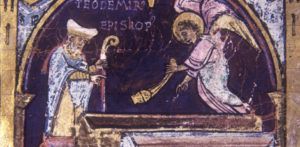
- Library services
- Norms for access and consulting
- Norms for loans for exhibits
- Norms for reproducing
- Click here to download the application form for reproducing documents and images from the ABCS for private use
- Click here to download the application form for reproducing documents and images from the ABCS for public use
- Click here to download the application form for borrowing documentation for temporary exhibits
- Click here to download the application form for borrowing documentation of bibliographical collections for temporary exhibits
- Click here to download the application form for attested copies of documents from ABCS
- Click here to see the reproduction rates of the ABCS
- Entities that collaborate with the Archive-Library
The Archive of the Cathedral of Santiago (ACS) is a private historical archive owned by the church and dependent on the Council of the Cathedral of Santiago. It keeps, preserves and serves the historical documentation it generates as it performs its activities, as well as that of other institutions related to it. It is managed by the Archivist-Librarian, a stable post whose functions correspond to a canon or may be temporarily carried out by staff who are not members of the Council, under the conditions established for each case with the agreement of the Archbishop. According to the Estatutos de la S.A.M.I. Catedral de Santiago de Compostela (Bylaws of the Holy, Apostolic and Metropolitan Church of the Cathedral of Santiago de Compostela), his competencies are:
- Preserve and catalogue the document and bibliographic collections, as per the valid norms. He will also be in charge, in coordination with the master canon of the chapel, of the preservation and growth of the Musical Archive.
- Increase the Chapter Library, especially with publications related to the Saint James theme.
- Provide access to the Archive and Chapter Library to researchers for the time and under the conditions established by the Cathedral Council. The documents and books may not be removed from the Archive or Library as loans, but must be consulted in situ.
- Inform the Cathedral Chapter regarding any matters that concern it.
According to the Regulation for Spanish Ecclesiastic Archives, “the cathedral archive consists not only of historical information, but also of all the historical documentation that is preserved therein, both the modern and also the one which is kept by the different council commissions, posts or offices. Once it has served its administrative purpose the documents must enter the archive in full order to become part of the documentary testimony of the life of the council”. This definition corresponds more accurately with that for the cathedral archives system, where the ACS functions as a chapter archive and periodically receives transfers from the cathedral administrative offices: Secretary (after forty years), Administration, Building, Museum and Pilgrimages.
Chart for the classification of Collections
In the Library of the Cathedral of Santiago ancient volumes, some incunabula, can be found alongside the most recent works of reference and published research. This fact reflects the triple dimension of the centre: chapter library, Saint James library and auxiliary library to the Cathedral Archive.
Through the donations by the precentor Alonso Sánchez de Ávila and Archbishop Álvaro de Isorna, the cathedral library was completed in 1454 and it was located in one of the cloister towers. It consisted of an ensemble of books put together to cover the needs of the canons: liturgical and biblical texts, which they used for their worshipping, and legal works, which they used to defend the interests of the cathedral Council, to advise the prelate or for their tasks of archbishop audience. The first documented reference to the temporary charge of guardian or doorman of the library is from the second half of that century. The guardian was in charge of the custody of the cathedral library, whose functions were constitutionally established by archbishop Gaspar de Zúñiga (1569): having the key to the library, opening it two days a week during established hours, cleaning the books and the library; remaining inside to prevent thefts.
After the founding of the University of Santiago, where from the beginning the most intellectually valuable canons were professors, the interest of the Council in its own library dwindled. This would explain its small size during the entire Modern Era, as mentioned by Ambrosio de Morales. It was not until the Enlightenment when the bases were established for what would later be the Chapter Library―which today can be visited as part of the cathedral’s museum itinerary―thanks to the testamentary donations from the canon maestrescuela (head of the Cathedral school), Diego Juan de Ulloa (1762) and the prior from Sar, Pedro Acuña y Malvar (1814).
With the general opening to the public of the Cathedral Archive in the 1980s, the role of the Library as the auxiliary centre for research carried out in the archive was strengthened. But with the new century two events took place which established the Saint James orientation of the Cathedral Library. The first was the approval, in the chapter session of 27 June 2000, of the general plan for the creation of a Saint James Documentation Centre. The second, which took place on the following year, was the allocation of a specific place for the creation of the Saint James Library.
Click here to browse the Bibliographical Collection
Click here to acces the Opac website for Bibliographical Collections

The Cathedral Archive-Library has promoted cultural dissemination through activities such as exhibits, conferences, presentations, guided tours, webs and blogs, etc, but also through the publication and joint publication and distribution of various of its own works or works on the Cathedral of Santiago de Compostela.
With respect to the publications by the ABCS (Spanish acronym for “Cathedral of Santiago Archive-Library”), collections, journals, monographs and exhibit catalogues were published, highlighting:
- The Colección Histórico-Documental de la Iglesia Compostelana, which began in 1998 and is devoted to the publication of monograph studies on medieval history, modern history, history of art, philology and musicology and, above all, to the systematic transcription of the most interesting documents that are kept at the Cathedral Archive.
- The Colección Archivium Sancti Iacobi, which began in 2007 with an initial series for the publication of Instrumentos de descripción from the Cathedral Archive.
- The journal Annuarium Sancti Iacobi which began in 2012 and whose common denominator is the documentary sources, research and works related to or issued by the ABCS, as the cultural expression of that centre, also including works on the documentation of the Church Archives and Libraries and, in general, on ecclesiastic documents.
The publications may be obtained through purchase, subscription or exchange. The Catálogo de venta de publicaciones can be browsed (Catálogo de publicaciones). To view the journal Annuarium Sancti Iacobi, you may visit the website www.annuariumsanctiiacobi.org. For the exchange of all the other publications from the ABCS, there is a bulletin of duplicates available.
If your institution would like to participate in this bibliographic exchange programme with the ABCS, please write a letter of proposal to our email or postal address (biblioteca@catedraldesantiago.es), attaching a copy of the publication to exchange or your institution’s publications catalogue. Clearly specify your postal address for deliveries.
Music

The cathedral of Compostela has a long musical tradition. In the 2nd century the Codex Calixtinus compiled pieces written for one, two and even three voices and devoted to the liturgy of the Apostle Saint James. The first references to the existence of a music chapel appear in the Renaissance. We know that in the 16th century, in addition to the choir of canons, which sang canto llano, there were professional singers and children who performed polyphony. Soon the instrumentalists or minstrels were admitted to play wind and string instruments in a chapel that traditionally included two organ players. This group of musicians was directed by a chapel master. In the 17th century several composers occupied that post until the arrival of José de Vaquedano, one of the most important musicians of the Spanish Baroque, part of whose works are kept in Santiago and who lived in the city until his death in 1711.
In the 18th century prestigious composers were at the head of the chapel, as is seen in the posts occupied by some after their stay in Santiago. Antonio Yangüas, for example, was appointed professor of music in Salamanca, and both Diego Muelas and Pedro Rodrigo achieved their magisterium from the convent of La Encarnación in Madrid. The works by these masters in general fall within the Baroque style, but some features suggest a future evolution towards a classist style. The great composer Melchor López is within the classic style. He succeeded the Italian Buono Chiodi in 1783 and remained in the post until his death in 1822. After the 19th century, the cathedral received the valuable musical contribution of Santiago Tafall, although he was only chapel master from 1895 to 1898. In the 20th century the magisterium of Manuel Soler, Nemesio García Carril and Xavier Méndez deserve a special mention.
Currently, vocal polyphonic music continues to be accepted by the II Vatican Council (SC 116). In general, the function of the choirs or scholae cantorum is highly valued by the Church (SC 29), especially in cathedrals: The treasure of sacred music is to be preserved and fostered with great care. Choirs must be diligently promoted, especially in cathedral churches(SC 114).
For this reason, the cathedral of Compostela wishes to preserve and share the sacred-musical treasure inherited, keeping the tradition alive and encouraging the use of new music in a balanced repertoire, where historical and present-day pieces coexist in perfect harmony. This desire becomes a reality through the activity of the Music Chapel (choir of adults and instrumentalists) and through the Escolanía (children’s choir), which help to solemnise the cathedral’s liturgy.
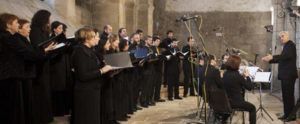
Music Chapel
Since 1988 the Music Chapel has sung under the direction of Miro Moreira and has been largely remodelled to developed into a mixed choir. Its main purpose is to sing in the worshipping acts of the cathedral and encourage the participation of the faithful in the celebrations. From a carefully chosen repertoire there stands out the transcription, interpretation and recording of famous chapel masters from Santiago. It also promotes the creation and release of new music for the cathedral’s liturgy.
Escolanía
The Escolanía, founded by Mariano Pérez Gutiérrez shortly after his appointment as chapel master in 1964, provided many children from Santiago with their first contact with music. Devoted above all to solemnise the cathedral’s liturgy, the choir soon embarked on a brilliant career, participating successfully for example in the prestigious contest in Loreto (Italy). At that sanctuary it sang a mass that was broadcasted by Eurovision throughout Europe in April 1968. Currently, the choir consists of 40 boys and girls and it was directed since it was relaunched in 2008 by José Luis Vázquez. From 2024 the conductor is Sofía Rodríguez. In addition to regularly singing the cathedral’s liturgy, the choir also participates in important events, such as the visit by Pope Benedict XVI to Santiago in 2010 (together with the Royal Philharmonic of Galicia) and in several events organised by the City Council of Santiago, the Council for Galician Culture and the regional government of the Xunta de Galicia, etc.
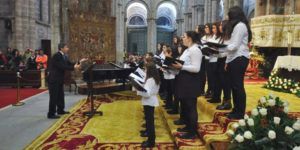
Coro Cardenal Quiroga
In addition to polyphony, in the cathedral of Santiago the two other genres of vocal music mentioned in the II Vatican Council are also performed, that is, Gregorian chant and popular religious chant.
The Church acknowledges Gregorian chant as specially suited to the Roman liturgy: therefore, other things being equal, it should be given pride of place in liturgical services (SC 116). On occasions the cathedral singers interpret certain pieces: antiphonies in specific processions and other chants throughout the mass, including several sections of the ordinarium. On the solemn eves of the Apostle Saint James (24 July) Gregorian fragments are sung (antiphony, psalmody, Salve Regina, etc.).
Religious singing by the people is to be intelligently fostered so that in devotions and sacred exercises, as also during liturgical services, the voices of the faithful may ring out according to the norms and requirements of the rubrics (SC 118). Singing, therefore, must be a means to promote the active participation of the people in the liturgy (SC 30, 113, 114, 121).
Fulfilling the Church prescriptions, it is the popular religious chant which predominates in the cathedral’s liturgy, surpassing the other genres in number of pieces programmed, in such a way that the pilgrims and other worshippers can express their faith through a sung prayer.
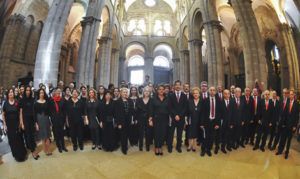

The sound of the organ, from the instrument specifically denominated by the II Vatican Council pipe organ, which it considers should be held in high esteem, for it is the traditional musical instrument which adds a wonderful splendour to the Church’s ceremonies, must lift up man’s mind to God and to higher things (SC 120).
The Compostela cathedral chapter grants great importance to the cathedral’s organ and it is played on a daily basis during the pilgrim’s mass (12:00 noon), during the evening mass (7:30 pm) and, in general, during all the solemnities, festivities and special celebrations that are held in the temple. Its use responds to the need to both accompany the singing of worshippers and choir as well as to play the solo pieces.
The present-day organ was manufactured by the firm Mascioni (Cuvio-Varese, Italy) in 1977. It is the only instrument by this firm installed in Spain. The inauguration concert (17 March 1978) was performed by the German organ player Erich Arndt, who at the time was the organ player at Saint Peter’s, in Rome.
The organ consists of a double structure on each side of the central nave. The Baroque cases that contain it were carved by Antonio Alfonsín and Miguel de Romay at the beginning of the 18th century. Although the instrument includes some tubes from previous organs (both on the facade as in the interior) it must be considered a new work, for the majority of the piping and all the other elements are by Mascioni. The windchests are sliding and the traction is electro-mechanical. The distribution of the sets corresponding to the three keyboards and pedalboard in the case is the following: great organ (II) and recitative-expressive (III) on the Gospel side and positive (I) and pedalboard on the Epistolary side. The console includes a number of accessories available for the organ player: plaques, buttons, reversible piston pedals and tilted pedals. These elements are for locking or cancelling adjustable combinations, activating and deactivating sets, joining the sets when they belong to different keyboards, starting up the crescendo general, the tutti, etc. In June 2005 Mascioni restored the organ’s traction with the addition of an electronic combiner whose software can store 3 programmable crescendi and 2490 combinations that can be copied into memory cards. These combinations can be activated one after the other with forward and reverse devices during the performance.
Currently, the musicians in charge of playing the cathedral’s organ are Manuel Cela, Adrián Regueiro and David Maceira.
Mascioni Organ – Layout
Masters of The Chapel (Baroque Period)
Master of The Chapel (Post Vatican Council Period)
Organs (Recordings)
Organ (Liturgical Repertoire: Mass, Advent Holy Week, Eastern)
Books and Scores
- ALÉN, Mª P.: Historia da Música Galega. Cantos, Cantigas e Cánticos. A Nosa Terra, 1997.
- ALÉN, Mª P.: La Capilla de Música de la Catedral de Santiago de Compostela. Ediciós do Castro, 1995.
- BRESCIA, M. (Ed.): Libro de Órgano de Melchor López (1781).Consorcio de Santiago, 2011.
- CAMPO OLASO, S.: La Escuela Echevarría de Organería en Galicia en El Órgano del Real Monasterio de Santa Clara de Santiago: Historia y restauración. Goetze & Gwynn, 2005. Págs. 17-135.
- CANCELA MONTES, B.: Santiago Tafall. Un Músico Compostelano en los Albores del Galleguismo. Alvarellos, 2010.
- CELA FOLGUEIRAS, M. J. y LÓPEZ FARIÑA, M. A.: Mariano Tafall y su Obra. Xunta de Galicia, 1996.
- CELA FOLGUEIRAS, M. J. y LÓPEZ FARIÑA, M. A.: Órgano, en Gran Enciclopedia Galega Silverio Cañada. Vol. XXXIII. El Progreso-Diario de Pontevedra, 2003. Págs. 161-166.
- DÍAZ Y DÍAZ, M.: El Códice Calixtino de la Catedral de Santiago de Compostela: Estudio codicológico y de Contenido. Centro de Estudios Jacobeos, 1988.
- JIMÉNEZ, E.: Acordes en Sol e Lúa. Os Quince Órganos do Noso Santiago Vello. Consello da Cultura Galega. 1999.
- LÓPEZ CALO, J.: Obras musicales de Fray José de Vaquedano. Cuadernos de Música en Compostela, 1990.
- LÓPEZ CALO, J.: La Música de Galicia, en Galicia Eterna. Vol. IV. Nauta. Págs. 877-931.
- LÓPEZ CALO, J.: La Música en la Catedral de Santiago. Vols. I-XI. Diputación Provincial de La Coruña. 1992-1999.
- LÓPEZ CALO, J.: La Música Medieval en Galicia. Fundación Barríe de la Maza, 1982.
- LÓPEZ CALO, J. y TRILLO, J.: Melchor López. Misa de Requiem. Cuadernos de Música en Compostela, 1987.
- LÓPEZ CALO, J. y VILLANUEVA, C. (Eds.): El Códice Calixtino y la Música de su Tiempo. Fundación Barríe de la Maza, 2001.
- TRILLO, J. y VILLANUEVA, C.: Polifonía Sacra Galega. Ediciós do Castro, 1982.
- VARIOS, A.: La Música en la Catedral de Santiago en Ritmo, nº 527, 1982. Págs. 8-30.
- WHITEHILL, W. y PRADO, G.: Liber Sancti Iacobi. Codex Calixtinus. 3 vols. Seminario de Estudios Gallegos, 1944.
- VILLANUEVA, C.: Las Lamentaciones de Fray José de Vaquedano. Universidade de Santiago de Compostela, 1992.
- VILLANUEVA, C.: El Pórtico de la Gloria. Música, Arte y Pensamiento. Universidade de Santiago de Compostela, 1988.